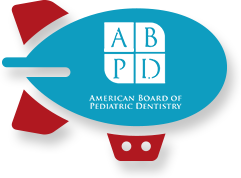How Do I Prevent Cavities?
Preventive dental care is important throughout life, especially at a young age. By practicing good oral hygiene at home and scheduling regular checkups with Union Pediatric Dentistry, your child can help keep her smile bright and healthy for many years to come. Here are a few simple ways to prevent the build-up of plaque and cavities:
- Make sure your child brushes his/her teeth at least twice a day with a soft-bristled toothbrush. Use fluoride toothpaste to remove food particles and plaque from the tooth surfaces. Also be sure to brush the top of the tongue; this will remove any extra plaque-causing food particles and help keep breath fresh!
- Make sure your child cleans between his/her teeth by flossing at least once a day. Decay-causing bacteria can linger between teeth where toothbrush bristles can't reach. Floss will help remove plaque and food particles from between the teeth and under the gumline.
- Make sure your child eats a balanced diet, and try to avoid frequent snacking and extra-sugary treats. Nutritious foods such as raw vegetables, plain yogurt, cheese, or fruit can help keep your child's smile healthy.
- Remember to schedule regular checkups with at our office every six months for a professional teeth cleaning, starting at age 1.
- Ask Dr. Greenhill, Dr. Jennison or Dr. Britt about dental sealants, a protective coating that can be applied to the chewing surfaces of the back teeth where decay often starts.
- If your child plays sports, be sure to ask Dr. Greenhill, Dr. Jennison or Dr. Britt about special mouthguards designed to protect your child’s smile.
- Brushing Instructions
-
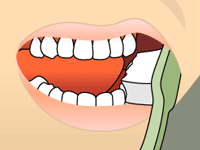
Brushing: Step 1
Place your toothbrush at a 45-degree angle to your gum.
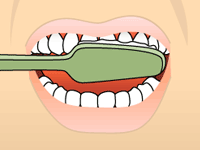
Brushing: Step 2
Brush gently in a circular motion.

Brushing: Step 3
Brush the outer, inner, and chewing surfaces of each tooth.
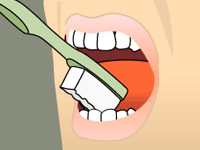
Brushing: Step 4
Use the tip of your brush for the inner surface of your front teeth.
- Flossing Instructions
-
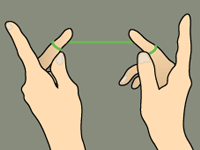
Flossing: Step 1
Wind about 18 inches of floss around your fingers as shown. Most of it should be wrapped around one finger, and the other finger takes it up as the floss is used.
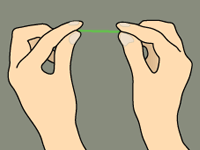
Flossing: Step 2
Use your thumbs and forefingers to guide about one inch of floss between your teeth.
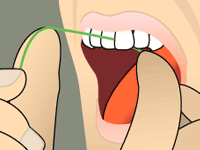
Flossing: Step 3
Holding the floss tightly, gently saw it between your teeth. Then curve the floss into a C-shape against one tooth and gently slide it beneath your gums.

Flossing: Step 4
Slide the floss up and down, repeating for each tooth.
Care Of Your Child's Teeth
Brushing Tips:
- Starting at birth, clean your child's gums with a soft cloth and water.
- As soon as your child's teeth erupt, brush them with a soft-bristled toothbrush.
- You can lay your young children on the couch or bed to brush their teeth if you struggle brushing while they are sitting up.
- Try an electric toothbrush, a toothbrush with their favorite character, or using a sticker chart to make toothbrushing more fun!
- When brushing, the parent should brush the child's teeth until they are old enough to do a good job on their own, around age 9.
Fluoride Toothpaste and Products
Fluoride is a naturally occurring element, which has shown to prevent tooth decay by as much as 50-70%. Despite the advantages, too little or too much fluoride can be detrimental to the teeth. With little or no fluoride, the teeth aren’t strengthened to help them resist cavities.
- If they are under the age of 3, use a small "smear" of toothpaste.
- If they're 3-5 years old, use a "pea-size" amount of toothpaste.
- Be sure and use an ADA-accepted fluoride toothpaste.
Remember that young children do not have the ability to brush their teeth effectively on their own. Children should spit out and not swallow excess toothpaste after brushing, in order to avoid fluorosis, which is typically a chalky white discoloration (brown in advanced cases) of the permanent teeth.
Ask Dr. Greenhill, Dr. Jennison or Dr. Britt if your child is a candidate for fluoride mouthwash or a prescription toothpaste, that has more fluoride in it than a typical toothpaste.
Good Diet = Healthy Teeth
Check out our Snack Guide
 Healthy eating habits lead to healthy teeth. Like the rest of the body, the teeth, bones and the soft tissues of the mouth need a well-balanced diet. Children should eat a variety of foods from the five major food groups. Most snacks that children eat can lead to cavity formation. The more frequently a child snacks, the greater the chance for tooth decay. How long food remains in the mouth also plays a role. For example, hard candy and breath mints stay in the mouth a long time, which cause longer acid attacks on tooth enamel. Sticky foods like fruit snacks and white bread crackers/pretzels stick in the grooves and are hard to remove, causing decay. If your child must snack, choose nutritious foods such as vegetables, whole grain snacks, or low-fat cheese, which are healthier and better for children’s teeth. Check out our snack guide that goes over foods that do and don't cause cavities!
Healthy eating habits lead to healthy teeth. Like the rest of the body, the teeth, bones and the soft tissues of the mouth need a well-balanced diet. Children should eat a variety of foods from the five major food groups. Most snacks that children eat can lead to cavity formation. The more frequently a child snacks, the greater the chance for tooth decay. How long food remains in the mouth also plays a role. For example, hard candy and breath mints stay in the mouth a long time, which cause longer acid attacks on tooth enamel. Sticky foods like fruit snacks and white bread crackers/pretzels stick in the grooves and are hard to remove, causing decay. If your child must snack, choose nutritious foods such as vegetables, whole grain snacks, or low-fat cheese, which are healthier and better for children’s teeth. Check out our snack guide that goes over foods that do and don't cause cavities!
Beware of Sports Drinks, Juice, and Other Sugary Drinks
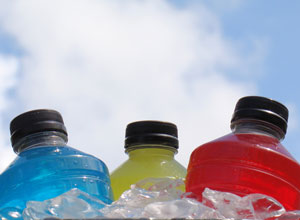
Due to the high sugar content and acids in juice and sports drinks, they have erosive potential and the ability to dissolve even fluoride-rich enamel, which can lead to cavities.
To minimize dental problems, children should avoid juice and sports drinks and hydrate with water before, during and after sports.
If juice and sports drinks are consumed:
- reduce the frequency and contact time
- limit to no more than once per day at a meal
- if unable to brush and floss after drinking, drink some water after these beverages to help rinse them off the teeth
Seal Out Decay
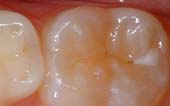 Before Sealant Applied
Before Sealant Applied 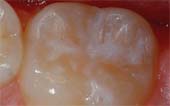 After Sealant Applied
After Sealant Applied
A sealant is a protective coating that is applied to the chewing surfaces (grooves) of the back teeth (premolars and molars), where four out of five cavities in children are found. This sealant acts as a barrier to food, plaque and acid, thus protecting the decay-prone areas of the teeth.


